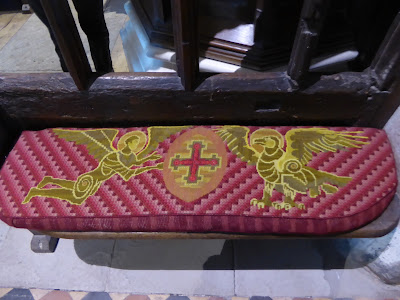to one of those buildings on the sculpture, St Peter's Church, a sturdy squat building whose churchyard slopes down to the sea and the buildings rear windows look out over the expanse of Morecambe Bay. Two of the remains of crosses can be seen either side of the path in the photo above. The core of the church is Anglo Saxon (mid 8th Century or before) and the door with a wooden bar and niches speaks across the centuries of times when refuge was taken from those with ill intent coming from the sea or land. Over the centuries the interior has been expanded from its Anglo-Saxon origin and altered with each era, Norman to Victorian. One of the church's great treasures is the Hogback Stone, a Viking grave cover, and the story it contains of the Legends of Sigmund and Sigurd the Dragon Slayer are told and can be seen here . Our church guide Richard Martin had a wealth of knowledge of the church and its history and has a handy guide available in the church for self tours.
The church was consecrated in 967 and as part of its millennium celebrations the parishioners in 1966 made kneelers and cushions portraying the area's industry and occupations. The four evangelists have pride of place
by the wooden screen in the chancel. This is St Mathew and St John (the eagle)
St Mark (the winged lion) and St Luke (the winged ox). The Cross with the crosses at the end is a Crosslet which also represents the four evangelists and the spreading of the gospel to the four corners of the earth. Moving outside towards St Patrick's Chapel
a different type of cross can be see, a Pommée, the apple shapes at the end represent the fruits of the Christian life and it is thought that
 |
| St Patrick's Chapel's Anglo Saxon Doorway |
Nobody knows their origin but they are certainly unique and, as demonstrated, it looks a cosy place to end ones days under ever changing skies. Perhaps there were sky burials here although the less romantic archaeological explanation is that they were probably reliquaries for bones and other materials as they were not big enough for bodies but I observe they appear to big enough for female bodies. The holes at the head were for crosses. We took our leave of the Anglo-Saxon chapel and returned to the church
another stone coffin but of one which at one time contained the body of a past rector of the church (the crumbled remains of his chalice can be seen in the church). We headed away
 |
| Remains of Anglo-Saxon Cross |
The Heysham Timeline can be seen on Heysham Heritage Association website here.




































